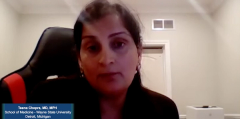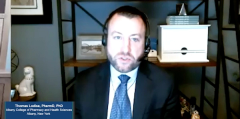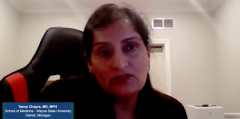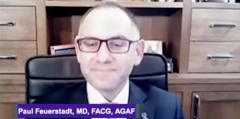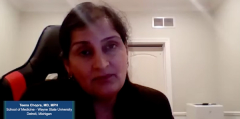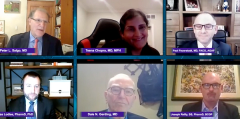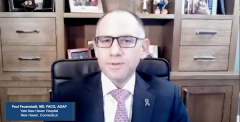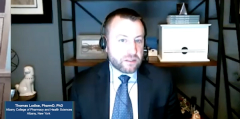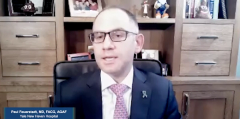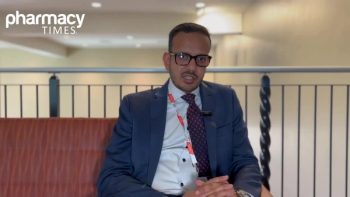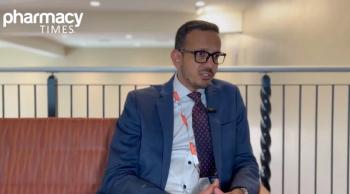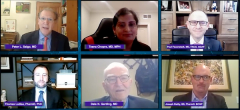
C. Difficile Treatment: Fidaxomicin
Episodes in this series

A discussion on fidaxomicin as treatment for C. difficile infections and clinician feedback on current challenges that impact its use in clinical practice.
Peter L. Salgo, MD: We’ve been talking about fidaxomicin [Dificid]. It is a relatively new drug; it’s a drug that I think may be unfamiliar to many clinicians. Tell me a little bit about it. How does the mechanism of action of fidaxomicin differ from other drugs that we may be familiar with? Tom, do you want to walk us through that?
Thomas Lodise, PharmD, PhD: It binds to bacterial RNA polymerase, so in many ways it’s like a macrolide. It is a macrocyclic antibiotic. Because it’s structurally different, it induces a cidal effect rather than static. Interesting point that many people are not aware of: not only is fidaxomicin very potent against CDI [Clostridioides difficile infection] but also good against VRE [vancomycin-resistant enterococci], as well as S aureus [Staphylococcus aureus]. It has a little bit of a broader spectrum and we’re even considering expanding its use, I think because it is insoluble. Its use right now is for Clostridioides difficile.
It’s 1 thing to talk about a mechanism, but as we discussed earlier, it’s more of a targeted therapy. There’s less disruption of the microbiota, and I think Paul [Feuerstadt, MD, FACG, AGAF] has done a very nice job explaining why that’s so important in the management of patients with CDI. In addition, in terms of its activity, from a MIC [minimum inhibitory concentration] standpoint the MICs are lower relative to vancomycin [Vancocin]. Its real distinguishing factor is it’s less disruption. That really drives a lot of these adverse outcomes. If you think about it, and I think Paul did a nice job summarizing some of the clinical findings from the trials, it’s not that initial clinical success; rather, it’s preventing that recurrence. When we think about that recurrence, it’s that prolonged disruption of the microbiota that drives a lot of the adverse outcomes we see in some of our CDI patients.
I will tell you, once those trials first become available, we’re a little bit ahead of our time in our VA [Veterans Affairs] population. We made a first line back in 2014 for the very reason we think about our patients—high risk of recurrence, I think Joe [Reilly, BS, PharmD, BCGP] talked about it; it’s kind of a tumbling effect. Those who get the first recurrence end up getting a second recurrence, and perhaps a third. When we think about treating CDI from a stewardship standpoint, our thought was, “How do we stop that event from moving forward?” Although we appreciate the similar clinical response, we were very impressed with a lot of the lower recurrence data and particularly with some of the altered dosing with fidaxomicin in 1 of their 2 trials.
Again, we can’t really compare across trials in terms of recurrence rates, but perhaps in some of these individuals when you’re treating that recurrent episode, using that tapered and pulse regimen may be beneficial. There’s still a little bit to learn about the drug, but I think what it has done has moved us forward in a more targeted way for treating CDI episodes. Again, that’s only 1 part of the story, as Paul has discussed. I think we still must figure out a better way to replenish the microbiota, but I think we’re getting there with some of these emerging therapies.
Peter L. Salgo, MD: Go ahead, Joe.
Joseph Reilly, BS, PharmD, BCGP: I just wanted to quickly add, Tom said that’s 1 part of the story, but a real part of the story that many people may not talk about is that looking at the data with fidaxomicin, it seems clear that this should be first-line; it’s associated with decreased recurrences, it has extra pharmacologic mechanisms, it can decrease the production of toxins, it can decrease sporulation, it has an active metabolite, it’s cidal. All of these examples; it causes less dysbiosis, even though patients with CDI may have dysbiosis just from the disease itself, and diarrhea. However, cost is an issue, and people were concerned about acquisition cost of a drug like that. When you look at the big picture, there is some data to say that the acquisition cost isn’t the primary concern, and that by using a potentially more expensive antibiotic you could wind up saving money in the long run and improve patient outcomes.
Peter L. Salgo, MD: Isn’t that always the question? I brought this up at panels like this repeatedly; that perhaps a new therapy, which is more expensive, saves money because of readmission rates and other comorbidities. The answer I get, and it’s often from the insurance companies, is, “Hey, we’re just looking at this. This is our formulary cost, and our formulary cost is not integrated with the rest of the cost structure in this hospital.”
Joseph Reilly, BS, PharmD, BCGP: It’s that silo budget mentality, just looking at how much we’re spending and not looking at the outcomes. If I spend more money and it’s saved somewhere else by decreasing admissions that might lose money, people often don’t take that into consideration.
Peter L. Salgo, MD: How do you blow this up? This isn’t on our agenda for tonight, but I’m going to ask it anyway. How do you blow up the silos and get the people in silo 1 talking to the people in silo 2 and saying, between us we’ll save money if we do what we all think we should do? Teena, I see a smile, you must speak on this.
Teena Chopra, MD, MPH: I think the patient-centered outcome research is the cornerstone where you can prove this—the quality that you see looking at readmission rates in these patients and comparing them. At Wayne State [University, Detroit, Michigan] we published a paper a few years ago where we were able to prove that the readmission rates were much higher in these patients. The patient-centered outcome research is 1 thing that can certainly help. Taking a broader view on the treatment therapeutics of C difficile, I think we are, as a nation and globally, we are moving more toward a microbiome-sparing treatment regimen in the next 5 years. That’s where we want to go and we want to get there, maybe eliminating vancomycin completely because, just like we talked about, fidaxomicin is more locally acting. It is microbiome sparing, it causes less dysbiosis, and so do some of the newer regimens that are out there.
Thomas Lodise, PharmD, PhD: I would say 2 things. I like Teena’s idea about being patient-centric. It’s really the way we were able to drive use of fidax [fidaxomicin] at our institution [Albany College of Pharmacy and Health Sciences, Albany, New York], when we had an ID champion. You think about it, VA [United States Department of Veterans Affairs], most patients are 75, and it’s more of a chronic than an acute disease in our patients. The patients who are seen repeatedly; you want to do whatever you can for them. You don’t want those who are acutely ill to become the chronic patients. The other thing I think is successful in addition to having a champion is almost a little bit of a top-down, so talking to the C-suite. Joe kind of talked about it. There’re penalties now with CDI, but even in the absence of a penalty, and Paul’s done some nice work in this area, you look at their 12-month cost; what is it, $70,000 with no recurrence, $120,000 for one recurrence? It just escalates with multiple recurrences.
I think the 1 thing that we’ve been trying to do, and this applies to all drugs, is how did you come up with that price? What is your return on investment? One thing I really like what they did with the 2020 provisional recommendations is providing a number needed to treat. So about 1 out of 10, that’s the benefit of fidaxomicin versus oral vancomycin; whether you’re treating initial or recurrent episode. We think about some of Dale’s [Gerding, MD] data looking at bezlotoxumab. In those high-risk patients, the number needed to treat is 1 out of 6 to get that return on investment.
I think we need to stop talking about drugs in terms of dollars and cents, which we’re never going to get away from. Rather saying, “If I do this, these are the adverse events that I’m going to prevent.” I think we must change the script a bit. Cost is always going to be the common denominator, but we need to talk about with this investment, this is going to be your return, and we must make that return in terms of dollars and cents as well.
Peter L. Salgo, MD: If you enjoyed this content, you should subscribe. We have an e-newsletter, and you can receive upcoming Peer Exchanges and other great content in your inbox—that’s right, electronically. I’ll see you next time. I’m Dr Peter Salgo. Thanks again for watching.
Newsletter
Stay informed on drug updates, treatment guidelines, and pharmacy practice trends—subscribe to Pharmacy Times for weekly clinical insights.

